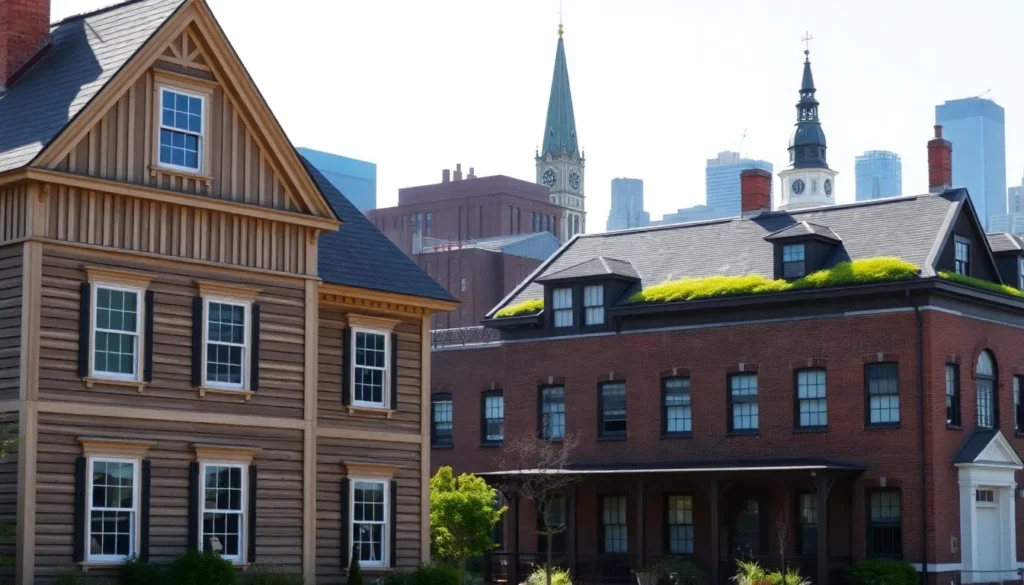Table of Contents
ToggleWhen you think about architecture, the Northeastern United States might not be the first region that pops into your mind. Yet, the rich tapestry of architectural styles woven through centuries is as intricate as a New England autumn. From Colonial houses that whisper tales of the past to modern sustainable designs that positively shout innovation, northeastern architecture deserves the spotlight. So grab your hard hat, or maybe just a cup of your favorite brew, and let’s jump into this architectural journey that showcases a diverse and evolving landscape.
Early Influences on Northeastern Architecture

Northeastern architecture isn’t solely a product of its local artisans or simple practicality: its roots stretch back to a blend of cultural influences, each leaving a mark long before modern skyscrapers climbed the skyline. The Native American influence is crucial, with their harmonious relationship with nature shaping early building designs. Longhouses and wigwams were not just structures: they represented a deep understanding of environment and community.
As European settlers arrived, they brought their architectural traditions with them. The Dutch, for instance, contributed to the unique gambrel roofs found in parts of the Northeast. The Puritans from England preferred simplicity and functionality in their dwellings, leading to the austere yet appealing homes seen in the Massachusetts Bay Colony. Together, these early influences laid the groundwork for a region rich in architectural diversity.
Colonial Architecture in the Northeast
Colonial architecture in the Northeast is a captivating blend of aesthetics and functionality, reflecting the diverse backgrounds of its settlers. Picture wooden framed houses with pitched roofs and large chimneys, the quintessential New England home. The saltbox style, characterized by its unique asymmetrical roofline, emerged during this period, offering practicality amid the harsh winters.
Colonial homes were often adorned with decorative elements borrowed from European trends, and elements like doubled-hung windows became standard. More than just aesthetics, these homes were symbols of prosperity and stability in a burgeoning land. Town commons blossomed, rustic facades turned into vibrant community hubs and the principles of symmetry and order began to take root, setting the stage for more elaborate designs in the years to follow.
The Rise of Industrial Architecture
With the dawn of the Industrial Revolution, northeastern architecture underwent a dramatic transformation. Factories began to dominate the landscape, particularly in cities like Lowell and Lawrence, Massachusetts. These weren’t just functional structures: they captured the essence of a rapidly changing society.
Iconic Architectural Styles in the Northeast
Industrial architecture often revealed itself through sturdy brick buildings, towering smokestacks, and expansive warehouse spaces that showcased the might of American manufacturing. Cities optimized their skyline, paving the way for what would become iconic and memorable cityscapes.
Characteristics of Federal and Greek Revival Styles
As the nation matured, the Federal and Greek Revival styles made their mark on northeastern architecture. The Federal style, with its restrained elegance, used flat roofs and decorative elements like swags and garlands, while the Greek Revival style drew inspiration from ancient temples, boasting large columns that exuded grandeur. These styles reflected a growing sense of national identity and pride.
The Gothic Revival and Its Impact
The Gothic Revival, emerging in the mid-19th century, brought an enchanting twist with pointed arches, intricate details, and soaring spires. Iconic structures such as Trinity Church in Boston and the St. Patrick’s Cathedral in New York were born out of this movement, fusing artistic expression with structural innovation and further enriching the architectural landscape.
Modern and Contemporary Architecture in the Northeast
Fast forward to the contemporary era, where architecture took an innovative turn again, merging with a growing awareness of sustainability. Northeastern cities began to incorporate renewable energy solutions and eco-friendly materials into their architectural practices.
Sustainable Design Trends in Northeastern Architecture
Sustainable design has become the norm rather than an exception. Architects now focus on creating spaces that not only look good but also respect the environment. Green roofs, energy-efficient windows, and natural ventilation systems are commonly featured in more recent projects.
Key Examples of Sustainable Architecture
Buildings like the Bullitt Center in Seattle, although not in the Northeast, inspire local projects. The Center for Sustainable Landscapes in Pittsburgh stands tall as a hallmark of sustainable design, championing biodiversity and efficiency. Locally, the Massachusetts Institute of Technology’s Media Lab embodies this spirit, enhancing functionality without sacrificing design.
The Future of Northeastern Architecture
Looking ahead, the future of northeastern architecture promises innovation fueled by cultural and social dynamics. With an emphasis on inclusivity, modern designs are adapting spaces to be accessible for all abilities. Urban planners and architects are increasingly collaborating with communities to ensure that new developments resonate with local identities.
Cultural and Social Influences on Architecture Trends
As cultures continue to blend, architectural designs will reflect these exchanges, resulting in hybrid styles that echo the rich histories of various communities. Expect to see more mixed-use developments that prioritize communal spaces, green parks, and public art, everything to foster community interactions and a cohesive societal fabric.


